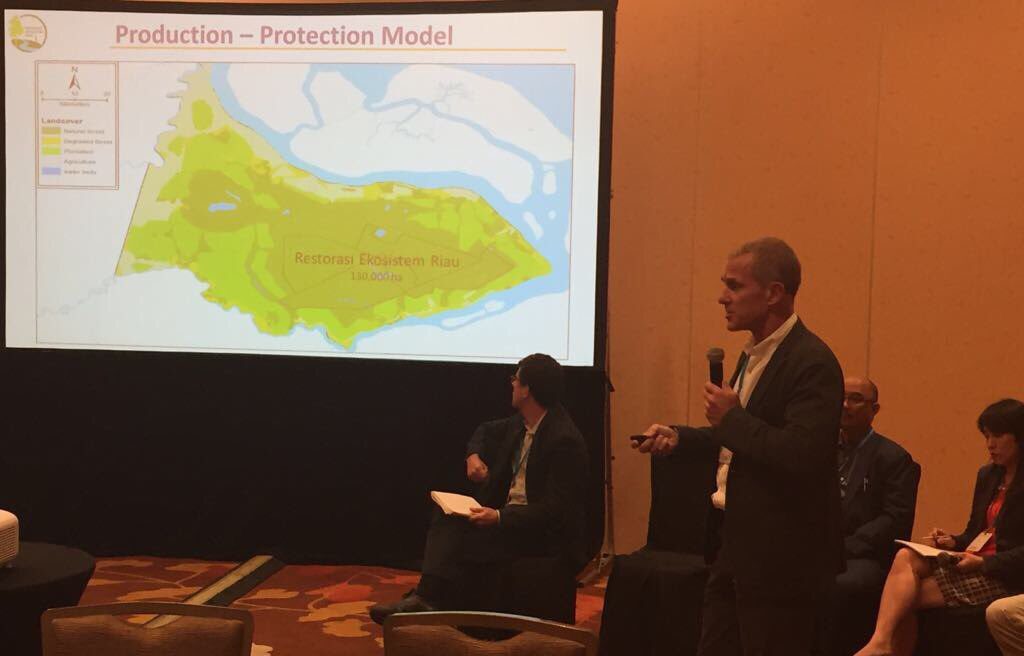Accelerating Progress on SDG 15 through Ecosystem Restoration
Restorasi Ekosistem Riau’s Head of Operations, Brad Sanders, recently spoke at the Responsible Business Forum in Singapore about the ecosystem restoration project and how it contributes to Sustainable Development Goal 15: Life on Land – Forest and Biodiversity Restoration. The following has been adapted from his remarks during a workshop session at the Forum.
Restorasi Ekosistem Riau, or RER, is one of the most exciting programs I have ever been involved in, and where I have the privilege to be the Head of Operations responsible for the restoration of 150,000 hectares of lowland tropical rainforest in central Sumatra, as well as leading a team of 170 dedicated people.
The program, which began in 2013, aims to promote sustainably managed forests to help reverse forest degradation and halt biodiversity loss. This purpose aligns with Sustainable Development Goal 15: Life on Land, though we intersect with other Goals as well. While the program precedes the Goals, they now provide a common language and a further layer of measurement that we can apply.

Our mission: Protect, Assess, Restore and Manage
In restoring this landscape, we are guided by a clear mission to ‘Protect, Assess, Restore and Manage’ the forest area we are responsible for. We do this through the production–protection model, whereby a fibre plantation ring serves as a protective buffer around the forest restoration area. This enhances our ability to protect and manage the tropical forest on peat domes which are located in the core of the Kampar Peninsula.
The progress of the program to date is based on three important factors: community buy-in, long-term finance and partnerships.
Establishing trust with the communities who continue to rely on forests for livelihood is an ongoing task and is key to protecting and restoring the area’s biodiversity. Over 17,000 people reside in nine communities along the Kampar River that borders the south side of the Kampar Peninsula. The majority of people are ethnic Malay, while the remainder is a mixture of Minang, Bugis, Nias, Batak, Jawa and Sunda.
Some of the families have a direct dependency on the forest and on the Kampar Peninsula. As well as providing employment to local communities, our engagement with the people of the area includes direct discussions on activities that can be sustainably supported, such as fishing or farming, while mitigating those that degrade the forest and its biodiversity.
Production for Protection
Second, the program is well-financed, enabling full implementation of the 60-year restoration licenses granted by the Ministry of Environment and Forestry. APRIL’s initial 10-year, US$100 million investment allows the RER team to focus on its mission. Where other initiatives have struggled due to inconsistent access to reliable funding, APRIL’s support means we have reliable and adequate finances to cover RER’s operational costs. It also demonstrates the benefits of the production-protection model, where commercial operations on the perimeter of our restoration area not only provide protection, but effectively fund ecosystem restoration and forest protection. While similar initiatives explore opportunities in carbon trade, eco-tourism, donor funding or the promotion of non-timber forest products trade, our experience shows that this is the most reliable, consistent and effective economic model for restoration that we’ve seen in Indonesia, especially given the extent of the resources that are required for ongoing active management.
Partnership and Scale
Third, RER has great partners, variously contributing to the development of significant biodiversity and carbon baseline assessments projects, strategic land use assessments and multi-stakeholder dialogues, and focused training of farmers and implementation of no-burn farming techniques to intensify crop production and improve the well-being of these communities.
To give a sense of the scale of the project, RER’s first Biodiversity Report recorded 72 species of mammals and confirmed the presence of five of Sumatra’s six cat species. As well, 15 of the species recorded are globally threatened with two – the Sumatran Tiger and Sunda Pangolin – listed as Critically Endangered. The plant inventory recorded 112 tree species and 40 non-tree species; the bird inventory 220 bird species from 53 families; and the amphibian and reptile inventories 14 and 61 species respectively. A recent report of bird life on the Kampar Peninsula updated the number of species present to 299.
An Active Presence
Today’s discussion is about how we can accelerate progress. In our view, accelerating progress is best achieved through engagement with government, communities and partners, and through a balanced, long-term approach to production and protection. Under this approach, we are able to maintain active management on the ground which is key to any conservation effort. Having an ‘active’ physical presence enables us to respond to daily or seasonal influences and to prevent fire or encroachment. It is worth noting that over the past two years there has been no fire and no encroachment into the RER area.
It is also about ensuring that conservation and protection are part of a holistic sustainable forest management strategy. In APRIL’s case, that describes its 1-for-1 approach, where it aims to conserve or protect one hectare of forest for every hectare of plantation. Restorasi Ekosistem Riau contributes to this goal, which is now more than 80% realised.




